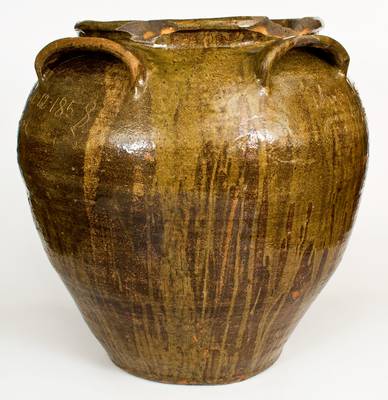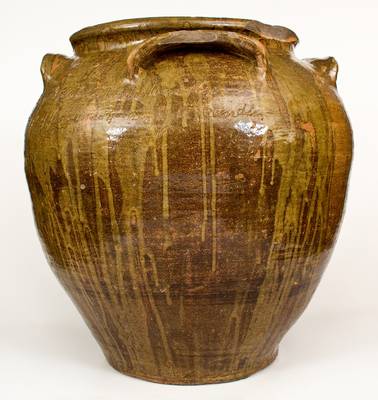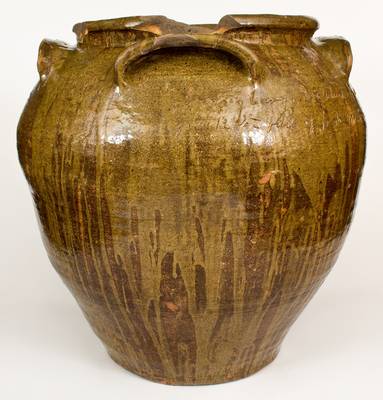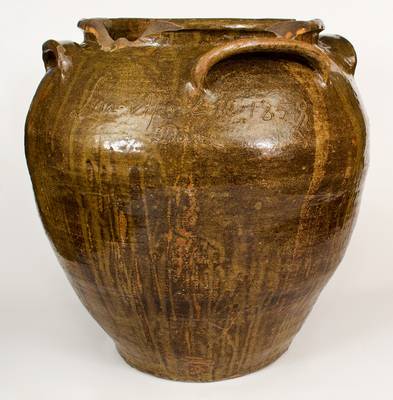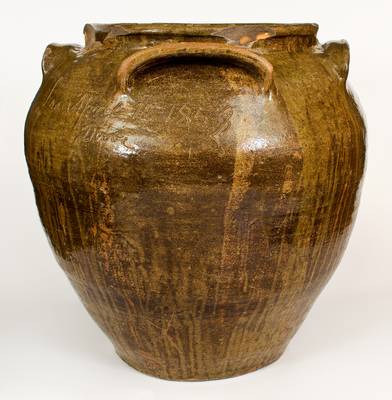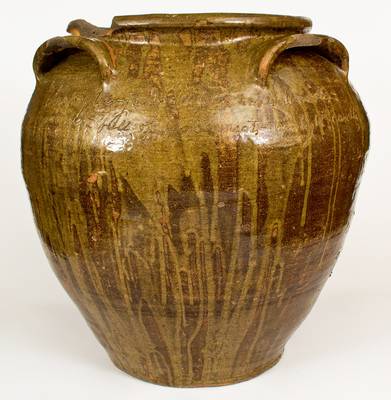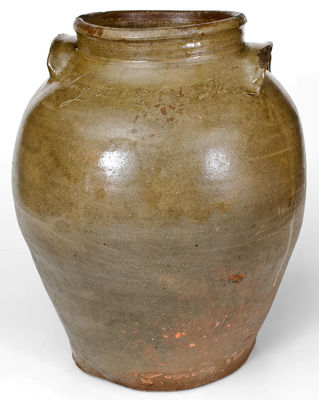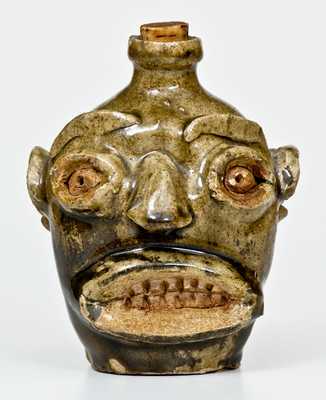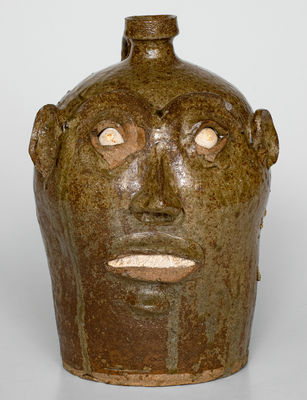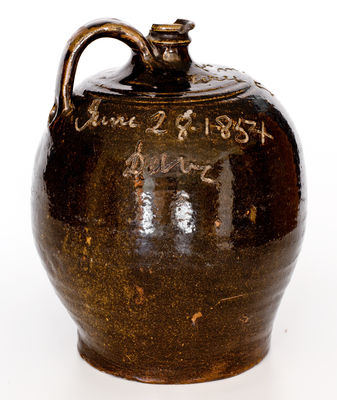Highly Important Twenty-Five-Gallon Four-Handled Stoneware Jar with Alkaline Glaze, Inscribed "A very Large Jar which has 4 handles / pack it full of fresh meats- then light candles," Signed "Lm . April 12 . 1858 / Dave," David Drake at Lewis Miles' Stony Bluff Manufactory, Edgefield District, SC, 1858, exceptionally large-sized, ovoid jar with semi-rounded rim and four curved slab handles. Surface covered in a poured alkaline glaze featuring raised olive-green streaks over a mottled brown and green ground. Incised across the shoulder in large script, "A very Large Jar which has 4 handles / pack it full of fresh meats- then light candles." Reverse shoulder incised in large script, "Lm . April 12 . 1858 / Dave." Incised between two handles with twenty-five small slash marks, denoting twenty-five gallons.
Discovered fifty years ago by the iconic Southern folk historian and author, Dr. John Burrison, this jar ranks among David Drake's greatest known works. Several factors--its size, form, glaze, and, most importantly, inclusion of an incised poem--define it as such. Measuring an imposing twenty-five gallons, the jar is among the largest signed examples of Drake's work known. Few of larger capacity have been documented. The vessel's grand proportions are denoted by twenty-five short incised slash marks, haphazardly scrawled in rows, between two handles. The jar is one of only four documented examples of Drake's signed work to feature his four-handled form--the decorative zenith of his output as a potter. Such pieces were designed with four handles because they were so large they would require multiple people to carry them, even without anything inside. A strictly Southern form, the four-handled jar is also seen on rare occasion in the work of other regional potters, including fellow Edgefield potter, Thomas Chandler, and the Lincoln County, NC potter, Daniel Seagle. Drake produced the largest known examples. Too large to dip for glazing, the vessel required a spontaneously-poured glaze, which imparts an active, vertically-flowing appearance to the surface. Different concentrations of the poured glaze produced different colors and textures on the jar's fired surface, with the heavier areas of application appearing as smooth and glossy raised stripes of olive-green. Such multi-toned glaze treatments are regarded as Drake's most visually striking and desirable. Of particular note is the exceptional luster of the glaze on this example, which is not seen in all of Drake's work.
The jar's incised poem directly comments on the object's unusual form and the purpose of it: "A very Large Jar which has 4 handles / pack it full of fresh meats- then light candles." Leonard Todd argues in his book, Carolina Clay: The Life and Legend of the Slave Potter Dave, that this particular couplet refers to the sealing of pottery jars with candle wax for preservation purposes (Todd, p. 241). Less than thirty-five intact David Drake poem vessels have been documented. All are considered highly important artifacts from a period when teaching an enslaved person to read or write was either discouraged or outright illegal. Today, Drake's poem vessels are viewed as a defiant contradiction to the social construct of the period and, more intimately, as a window into the mind and personality of one enslaved artist. Through inscribing his ware, Drake was granted an identity as an artist that other enslaved craftsmen, now lost to history, would never find. The jar continues with an inscription on the opposite side: "Lm . April 12 . 1858 / Dave," which includes the initials of Drake's owner during this period, Lewis Miles, who operated a stoneware manufactory at Stony Bluff, located in the Horse Creek Valley region of South Carolina's Edgefield District from 1840 t0 1868. The jar's inscribed date places it within a three-week span of March 31 to April 21, 1858, from which four large poem jars have survived--a period of heightened expression by the potter, which may never fully be explained. From this group, a two-handled jar currently on display at the Metropolitan Museum of Art was produced just nine days after the jar to be auctioned, and includes both a poem and dedication to the vessel's owner.
Dr. Burrison's four-handled "Dave" poem jar embodies all of the characteristics one seeks in Drake's finest work, qualified by its poetic couplet, size, form, and glaze. With the rise in awareness of David Drake as one of America's leading African-American artists, this jar can, on a broader level, also be regarded as one of the greatest ceramic objects ever produced in this country. As a limited number of his poem vessels have survived, the majority of which are currently housed in the nation's leading institutions, our Summer 2021 auction offers an extremely rare opportunity that may never arise again. Provenance: Collection of Dr. John A. Burrison, Atlanta, GA; on loan to the Atlanta History Center, Atlanta, GA since 1981. Exhibited: Atlanta History Center Folk Life Gallery, Atlanta, GA since 1981. Literature: This jar is among the most widely-published American ceramic works that we are aware of. Select publication history includes the following: Illustrated in Burrison, John A. Brothers in Clay: The Story of Georgia Folk Pottery. Athens, University of Georgia Press, 2008, pp. 20-21; Illustrated and discussed in Burrison, John A. Shaping Traditions: Folk Arts in a Changing South. Athens, University of Georgia Press, 2000, pp. 5-7; Discussed in Burrison, John A. "Dave the Potter and His Place in American Ceramic History," part of the transcribed and published symposium, Pottery, Poetry and Politics Surrounding the Enslaved African-American Potter, Dave. Columbia, University of South Carolina, 1998, p. 28; Discussed in Burrison, John A. "African-American Folk Pottery in the South," Southern Folklore Quarterly 42, 1978; Discussed in Vlach, John Michael. The Afro-American Tradition in Decorative Arts. Athens, University of Georgia Press, 1990 (originally published Cleveland, Cleveland Museum of Art, 1978), p. 79; Discussed in Chaney, Michael A., ed., Where is All My Relation? The Poetics of Dave the Potter. Oxford, Oxford University Press, 2014, pp. 37, 92, 138, and 144; Poem listed in Baldwin, Cinda K. Great and Noble Jar: Traditional Stoneware of South Carolina. Athens, University of Georgia Press, 1993, p. 195; Mentioned in Miller, James A. "Dave the Potter and the Origins of African-American Poetry" in I made this jar. . . The Life and Works of the Enslaved African-American Potter, Dave. Edited by Jill Beute Koverman, Columbia, University of South Carolina, 1998, p. 57. Also illustrated in Koverman, p. 62. Illustrated and discussed in Todd, Leonard. Carolina Clay: The Life and Legend of the Slave Potter Dave. New York, W.W. Norton & Co., 2008, p. 202, 241; Burns, Sarah and John Davis. American Art to 1900: A Documentary History. Berkeley and Los Angeles, University of California Press, 2009, p. 334; Discussed in Patton, Sharon F. African-American Art. Oxford, Oxford University Press, 1998, p. 65; Mentioned in Sanders, Nancy I. America's Black Founders: Revolutionary Heroes and Early Leaders with 21 Activities, Chicago, Chicago Review Press, 2010, p. 111; Mentioned in Miller, Randall M. and John David Smith, ed. Dictionary of Afro-American Slavery. Westport, Greenwood Publishing Group, 1988, p. 66; Listed in Goldberg, Arthur F. and James Witkowski. "Beneath his Magic Touch: The Dated Vessels of the African-American Slave Potter Dave." Ceramics in America 2006, pp. 67, 86. Four losses to rim, measuring 8 3/4", 6 1/2", 6 1/2", and 4 1/4". A 4" flake to one handle and a 3 1/2" flake to a second handle. A few other small chips to handles. A 3/4" bullet hole to shoulder. A 4 1/2" X-shaped surface line, which occurred in the firing, not visible on the interior. A small base chip. Remarkably, this jar survives with no cracks, a rarity for Dave pieces of this size. H 24 1/2"; Diam. (at rim) 16 3/4" ; Diam. (at widest) approx. 22" ; Circum. approx. 77".


